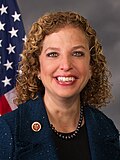Top Qs
Timeline
Chat
Perspective
Florida's congressional districts
U.S. House districts in the state of Florida From Wikipedia, the free encyclopedia
Remove ads
Florida is divided into 28 congressional districts, each represented by a member of the United States House of Representatives. After the 2020 census, the number of Florida's seats was increased from 27 to 28, due to the state's increase in population, and subsequent reapportionment in 2022.[1]

Interactive map version
Current districts and representatives
Summarize
Perspective
Republicans have complete control of the congressional redistricting process in Florida, as any new maps are drawn and passed by the Republican-held state legislature and signed into law by the Republican governor. This has resulted in Florida’s maps being an ‘extreme’ partisan gerrymander in favor of the Republican Party, with few competitive districts.[2] Despite challenges from groups such as the NAACP and Common Cause, the current map was upheld by a panel of judges from the United States District Court for the Northern District of Florida, which found that, while a partisan gerrymander, there was not sufficient evidence that the maps are a racial gerrymander.[3]
List of members of the United States House delegation from Florida, their terms, their district boundaries, and the district political ratings according to the CPVI. The delegation has a total of 28 members, including 8 Democrats and 20 Republicans.
Remove ads
Historical district boundaries
- Districts circa 1894
- Districts from 2003 to 2013
- Districts from 2013 to 2017
- Districts from 2017 to 2023
Obsolete districts
History
Summarize
Perspective
2010 redistricting
In 2010 more than 63 percent of Florida voters approved the initiated Amendments 5 and 6, known as the "Fair District Amendments," to the state constitution, over the objections of the Republican-controlled legislature. These are intended to promote fairness in congressional districts[6] and "prohibit lawmakers from intentionally drawing districts that favor incumbents or political parties."[7][clarification needed]
The legislature had adopted new districts in 2012 as a result of the 2010 census. Their product was soon challenged in early 2011 by groups who had worked for passage of the amendments, including the League of Women Voters and Common Cause.[7] The trial revealed much secret dealings by party operatives and lawmakers; the court set a new legal standard. At one point the court excluded the press and shut down the TV feed in order to allow three hours of testimony by a political operative.[7]
On July 9, 2014, a Florida judge ruled that state Republicans had illegally drawn the state's congressional districts. Judge Terry P. Lewis of Florida's Second Judicial Circuit ordered that the 5th and 10th districts be redrawn.[8] On appeal, the Florida Supreme Court ruled on July 9, 2015 that several more districts had to be redrawn, and that the legislature had unconstitutionally worked to benefit the Republican Party. The historic ruling was considered likely to affect most of the state's 27 districts.[7]
On December 2, 2015, the state supreme court approved a remedial plan for districting for the 2016 elections.[9][10][11] All but Districts 1, 8, and 19 were altered in some way by the plan.
2020 redistricting
This section is empty. You can help by adding to it. (January 2023) |
See also
Notes
28 districts.
References
External links
Wikiwand - on
Seamless Wikipedia browsing. On steroids.
Remove ads




























































